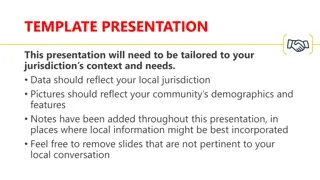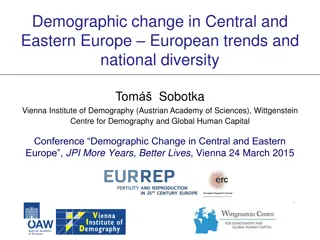Understanding the Demographic Transition Model
The Demographic Transition Model describes the shift from high birth and death rates to low rates as societies advance technologically and economically. It consists of four stages, each marked by specific characteristics and factors influencing population growth. From high mortality and fertility ra
3 views • 12 slides
Tools and Extensions for NTA and Demographic Dividend in Africa
This content discusses the tools and extensions related to National Transfer Accounts (NTA) and Demographic Dividend in Africa, focusing on quantifying domestic production, consumption, and progress in harnessing demographic dividend. It includes NTA profiles for African countries, NTTA profiles for
2 views • 10 slides
Progress Update on Demographic Accounts Project for June 2022 Delivery
The update covers the progress of the Demographic Accounts project, including proof-of-concept milestones, annual local authority level estimations, model approaches, and data preprocessing. The project aims to deliver demographic accounts by age, sex, and local authority, incorporating data from va
0 views • 15 slides
Understanding Demography: Population Trends and Analysis
Demography is the study of population size, distribution, and composition, encompassing elements such as mortality, natality, migration, and demographic forces. Population census plays a crucial role in collecting and analyzing demographic data, with methods like De Jure and De Facto census. Inter-c
6 views • 21 slides
Understanding Interest Groups in Texas
Explore the role and influence of interest groups in Texas politics, including theories, types of groups, activities, and the impact of lobbying. Learn about incentives for joining, the free rider problem, and the various benefits interest groups offer. Discover the different types of interest group
0 views • 15 slides
Proposal for National MPI using SHDS Data in Somalia
The proposal discusses the creation of a National Multidimensional Poverty Index (MPI) for Somalia using data from the Somali Health and Demographic Survey (SHDS). The SHDS, with a sample size of 16,360 households, aims to provide insights into the health and demographic characteristics of the Somal
0 views • 26 slides
Demographic Human Capital DGE Model for High-Growth Scenarios in Rwanda
This study focuses on a Demographic Human Capital Dynamic General Equilibrium (D-DGE) model for analyzing high-growth scenarios in Rwanda from 2016 to 2050. It explores the interactions of demographic dynamics, human capital, public infrastructure, and debt within a long-term growth framework. The m
0 views • 28 slides
Geography Practice Exam Round 1 Questions
Practice your AP Human Geography knowledge with these multiple-choice questions covering topics such as demographic indicators, cultural diffusion, population growth, cultural landscapes, and urban land use patterns. Test your understanding of concepts like fertility rates, diffusion types, populati
0 views • 106 slides
Harnessing a Demographic Dividend for Equitable Growth: A Gender Perspective
Harnessing a demographic dividend involves leveraging a decrease in fertility rates to shift the population towards a larger working-age group, reducing dependency ratios and creating opportunities for economic and social investments. This process requires the right policies and frameworks. The 3 Es
0 views • 11 slides
Challenges and Opportunities in China's Demographic Dividend
China's rapid economic growth was fueled by its demographic dividend, but it now faces challenges such as population aging, rising labor costs, and avoiding the middle-income trap. The country has transitioned to a "new normal" of slower growth, structural changes, and evolving growth drivers. Under
0 views • 63 slides
Understanding Demographic Indicators for Gender Analysis Workshop
This workshop delves into the significance of demographic indicators for analyzing gender relations. Covering topics such as demography, gender, data sources, sex ratio, fertility rates, and more, participants will explore key aspects of population dynamics. Through interactive sessions, attendees w
6 views • 18 slides
Understanding Demography and Population Dynamics
Demography is the scientific study of human population focusing on changes in size, composition, and distribution. Forces such as mortality, fertility, and migration impact population changes. The transition from a developing to a developed country involves passing through various stages with differ
0 views • 30 slides
Demographic Comparison for Representativeness in Oregon ACT Program Evaluation Focus Groups
The study evaluates the representativeness of focus group samples in the Oregon ACT Program. It compares demographic characteristics such as age, gender, race/ethnicity, medication use, and days homeless between the entire ACT population and focus group participants. The findings show differences in
0 views • 28 slides
2020 Census Hiring Process for Demographic Analysis & Population Projection System (DAPPS) Employees
Explore job opportunities with the 2020 Census in roles such as recruiting assistants, field supervisors, enumerators, clerks, and more. Learn about the application process, online assessments, eligibility criteria, and reasons for ineligibility. Receive insights on the selection process timeline an
0 views • 10 slides
Representation of Abstract Groups through Graphs
Explore the representation of abstract groups as automorphism groups of graphs, touching on topics such as the existence of graphs whose automorphism groups are isomorphic to given abstract groups, the cardinality of connected graphs satisfying specific properties, and questions regarding the cardin
0 views • 16 slides
Demographic and Government Overview of Iron Mountain, Michigan
The data provides a snapshot of the demographic and government characteristics of Iron Mountain, Michigan, including population statistics, household income distribution, workforce education attainment, city government structure, as well as details on the county and state government representation i
0 views • 14 slides
Demographic Shift and Health Trends in Minnesota
Minnesota is facing a significant demographic shift with the aging population projected to increase, leading to an increased need for health and long-term care services. The longer life expectancy and retirement age highlights the importance of financial planning. Understanding the leading causes of
0 views • 16 slides
Demographic Insights on Race/Ethnicity, Health, and Care in the U.S.
The data reveals the distribution of the U.S. population by race/ethnicity in 2010, highlighting percentages for Native Hawaiian/Other Pacific Islander, Asian, Hispanic, Black, White, and other groups. It also presents statistics on the distribution of Hispanic Americans, no usual source of care for
0 views • 23 slides
Nordic Family Policy and Demographic Consequences Overview
This presentation discusses the outcomes of family policy in Nordic countries, focusing on aspects such as female labor force participation, male participation in childcare, fertility rates, family dissolution, poverty among children, and more. It also examines the influence of Nordic family policy
0 views • 19 slides
Overview of Laos Population Census Methods and Trends
Laos, a landlocked country with a population of 6 million inhabitants, conducts its population census using the De Jure method. Demographic data is collected through a variety of methods including vital registration and actuarial methods due to poor registration in rural and ethnic areas. Quality ma
0 views • 7 slides
Demographic Analysis and Changes in M250 Module Engagement
The M250 module underwent significant changes in 2021, introducing a new curriculum with practical activities and automated feedback features. The demographic analysis revealed a majority of students aged 25-34, with completion rates varying across different demographic groups. Overall, students fou
1 views • 28 slides
Improvement of Population and Vital Statistics Metadata in the Demographic Yearbook System
The Demographic Yearbook system focuses on enhancing population and vital statistics metadata to ensure accurate and concise reflection of population concepts across 230+ countries. It involves annual collection of official national population estimates, vital statistics, and UN international travel
0 views • 16 slides
Understanding Population Pyramids and Demographic Trends in China
Explore the population pyramids, demographic trends, and economic development stages in China. Discover key features such as gender distribution, age bands, and dependency ratios. Learn about China's historical population data, urbanization rate, and median age. Gain insights into how China's popula
0 views • 22 slides
Understanding Demographic Overlay Reports for Education Accountability
Demographic Overlay Reports play a crucial role in education accountability by certifying student demographics for assessment purposes. This report, sourced from district Student Information Systems (SIS), requires careful review to ensure accurate data transmission to the assessment platform. Any d
0 views • 15 slides
Understanding Pressure Groups and Their Influence on Decision-Making
Pressure groups are formed by like-minded individuals to influence decision-makers by drawing attention to specific issues, with the aim of impacting legislation and existing laws. People join pressure groups seeking to address particular issues more effectively than through mainstream politics. Whi
0 views • 25 slides
Measuring Student Participation in Higher Education in South Africa
This paper discusses the measurement of student participation in higher education in South Africa, focusing on enrollment rates, demographic distributions, and age groups from 2001 to 2007. It highlights the government's role in steering quality planning and funding in the public higher education sy
0 views • 24 slides
Equity Gaps Among Potential Students: Fall 2016 Analysis
Examination of equity gaps among potential students applying but not enrolling in Fall 2016 at Crafton Hills. The study investigates demographic characteristics (ethnicity, gender, age) and engagement behaviors through application, orientation, and assessment data. Disproportionate impact and statis
1 views • 13 slides
Influence of Personal Demographic and Institutional Variables on Venture Creation in Small Technology-Oriented Ventures
This research study explores the impact of personal demographic and institutional factors on venture creation in small technology-oriented ventures. It delves into the influence of individual characteristics like age, gender, education, and social institutions such as family role models on entrepren
0 views • 39 slides
Understanding Ethnicity in Scotland: Diversity, Health Disparities & Demographic Shifts
The data presented delves into the significance of ethnicity in Scotland, highlighting health trends and demographic changes. It showcases disparities in disease prevalence among ethnic groups, variations in healthcare screening attendance, and the evolving diversity landscape. From examining the im
0 views • 12 slides
Achieving Demographic Fairness in Clustering: Balancing Impact and Equality
This content discusses the importance of demographic fairness and balance in clustering algorithms, drawing inspiration from legal cases like Griggs vs. Duke Power Co. The focus is on mitigating disparate impact and ensuring proportional representation of protected groups in clustering processes. Th
0 views • 36 slides
Demographic Shifts in Central and Eastern Europe Post-1989: A Closer Look
The collapse of state socialism in Central and Eastern Europe in 1989-91 brought about significant changes, leading to economic and social transformations. The region experienced new political and economic freedoms, although inequalities grew. Unique demographic divides between East and West Europe
0 views • 43 slides
Adolescent Fertility Trends in Sub-Saharan Africa: A Critical Analysis
Investigating adolescent fertility rates in Sub-Saharan Africa reveals disparities in existing measurements and raises questions about the relationship between adolescent birth rates, unmet needs for contraception, and gender equity. Utilizing data from Health and Demographic Surveillance Systems al
0 views • 21 slides
Demographic Trends and Future Projections: A Comprehensive Analysis
Explore the demographic transformation from past to future, including population growth rates, urbanization trends, and county-level projections in Utah. Learn about the impact of migration on population change and key factors influencing demographic shifts. Data sources include the Bureau of the Ce
0 views • 50 slides
Insights from Anishinabek Nation Socio-Demographic Study Presentation
An overview of the Anishinabek Nation Socio-Demographic Study presented by Leanna Farr focused on various factors such as language usage, population trends, legislative impacts, and projections related to the Registered Indian population growth. The study highlights demographic shifts, language patt
0 views • 16 slides
Importance of Measuring Race and Ethnicity in Health Disparities
This presentation discusses the significance of measuring race and ethnicity in addressing health disparities, underlining the impact of social, economic, and environmental factors on various demographic groups. It covers federal data collection guidelines, best practices, and the use of demographic
0 views • 14 slides
Understanding Population Pyramids for Analyzing Population Trends
Population pyramids are graphical illustrations that showcase the distribution of age groups within a population, segmented by gender. By observing and documenting the patterns of population pyramids, one can discern trends such as rapid growth, slow growth, or negative growth, which are influenced
0 views • 7 slides
Student Interest Group Policy Changes Overview
Student Interest Group Policy Changes involve implementing new criteria for student interest groups, setting membership requirements for preclinical and clinical years, consolidating existing groups, and establishing new interest groups. The policy includes guidelines on events, fundraisers, faculty
0 views • 9 slides
2014 Staff Well-being Survey Results Summary Presentation
The presentation by Nancy Welch from the Office of Institutional Research and Planning on November 4, 2014, provided an overview of the survey administration, overall results, notable demographic differences, and next steps. It covered aspects like overall satisfaction, diversity, multiculturalism,
0 views • 75 slides
Understanding Cyclic Groups and Discrete Logarithms
Exploring the concepts of cyclic groups and discrete logarithms in group theory. This presentation covers the definition of generators, examples of cyclic groups, important theorems related to prime orders and cyclic groups, uniform sampling in cyclic groups, and the discrete logarithm problem. Exam
0 views • 14 slides
Enhancing Demographic Accounts for Informed Decision-Making
The presentation discusses the prototype model for demographic accounts to inform the 2023 National Statistician's recommendation on the traditional census. It delves into the limitations of the current system, the structure of demographic accounts, advantages and disadvantages, exploratory analysis
0 views • 29 slides







































